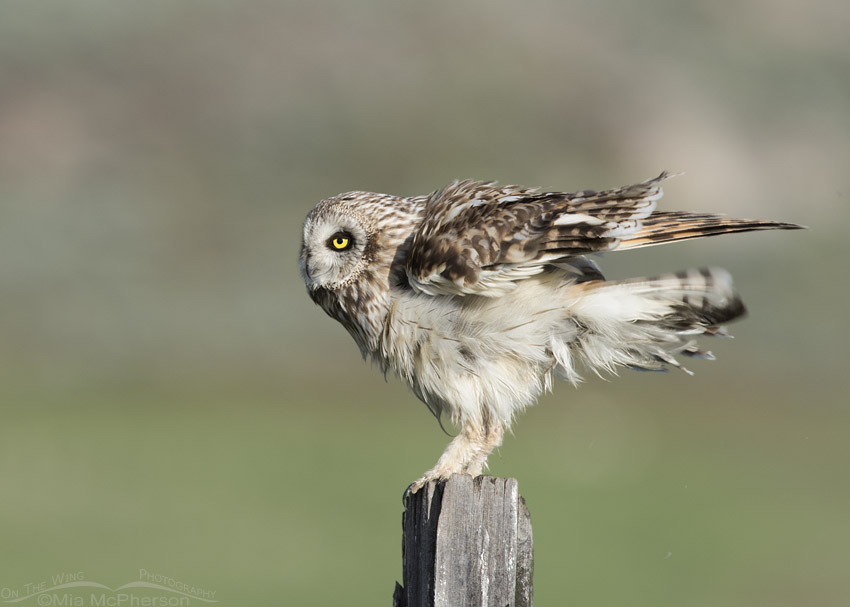 Rousing male Short-eared Owl – Nikon D810, f10, 1/640, ISO 400, Nikkor 500mm VR with 1.4x TC, natural light, not baited
Rousing male Short-eared Owl – Nikon D810, f10, 1/640, ISO 400, Nikkor 500mm VR with 1.4x TC, natural light, not baited
Last week I spent a lot of time photographing more than a dozen Short-eared Owls in various locations around northern Utah. Some were chicks, fledglings, females and males. I was able to see and photograph a long Short-eared Owl preening session where I could see the owl’s ear canal, uropygial gland and some extremely interesting and twisted poses.
 Male Short-eared Owl staring – Nikon D810, f10, 1/640, ISO 400, Nikkor 500mm VR with 1.4x TC, natural light, not baited
Male Short-eared Owl staring – Nikon D810, f10, 1/640, ISO 400, Nikkor 500mm VR with 1.4x TC, natural light, not baited
When the male owl didn’t take off after it roused I decided to move my Jeep a little bit to avoid having the bright out of focus rocks in the distance behind the owl while I photographed it. They distracted me even through the viewfinder.
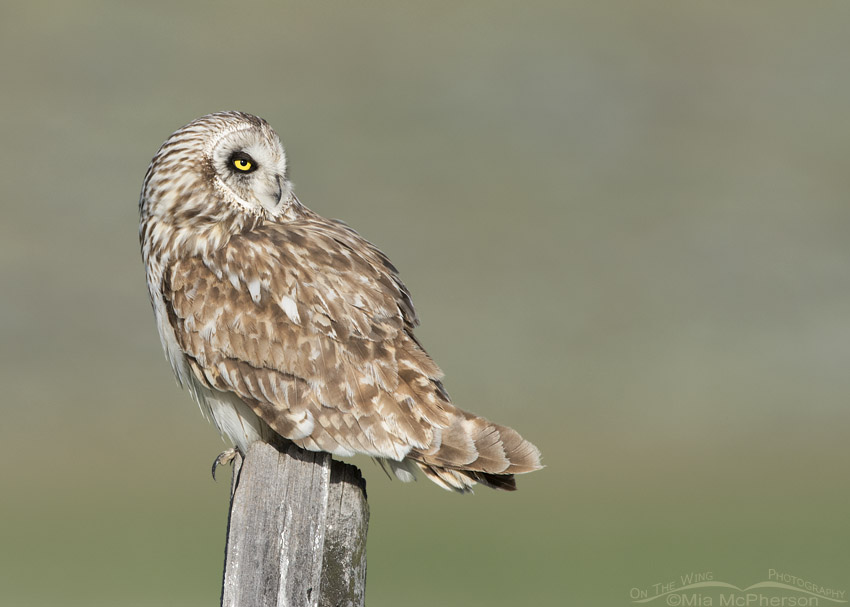 Relaxed Short-eared Owl male – Nikon D810, f10, 1/640, ISO 400, Nikkor 500mm VR with 1.4x TC, natural light, not baited
Relaxed Short-eared Owl male – Nikon D810, f10, 1/640, ISO 400, Nikkor 500mm VR with 1.4x TC, natural light, not baited
The owl wasn’t bothered when I moved that little bit or by my presence, it just looked around the fields in front of it and behind it. I was starting to think the owl was going to go to sleep on me.
 Short-eared Owl squinting while preening – Nikon D810, f10, 1/640, ISO 400, Nikkor 500mm VR with 1.4x TC, natural light, not baited
Short-eared Owl squinting while preening – Nikon D810, f10, 1/640, ISO 400, Nikkor 500mm VR with 1.4x TC, natural light, not baited
But then he started to preen and I locked my focus on him, taking frame after frame while enjoying and being enthralled by every move he made. The funny looks…
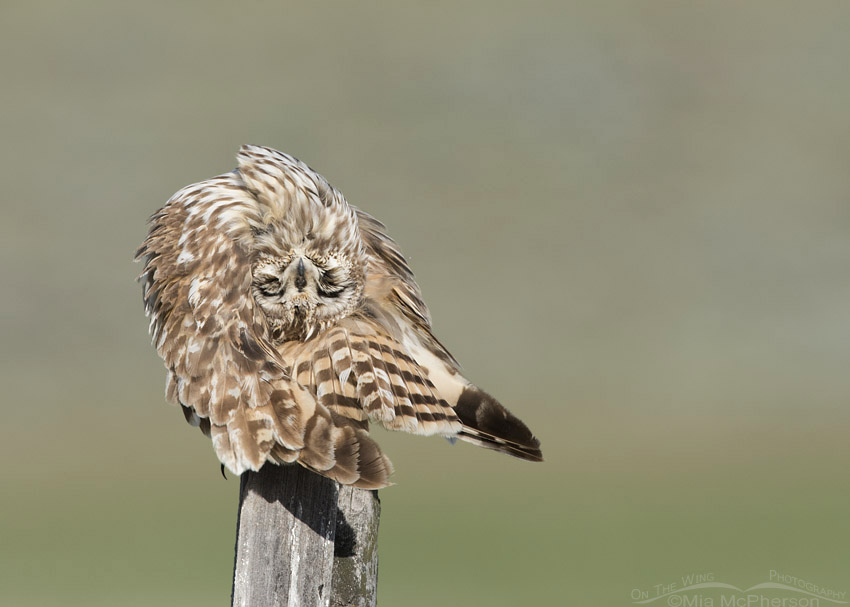 Short-eared Owl rubbing its uropygial gland – Nikon D810, f10, 1/640, ISO 400, Nikkor 500mm VR with 1.4x TC, natural light, not baited
Short-eared Owl rubbing its uropygial gland – Nikon D810, f10, 1/640, ISO 400, Nikkor 500mm VR with 1.4x TC, natural light, not baited
The poses it got into… The owl is actually rubbing the back of its head on its uropygial gland, or preening gland, in this frame. The owl looks topsy-turvy, doesn’t it? I kind of wish it would have had its eyes open when it did this but I’m happy with what I got.
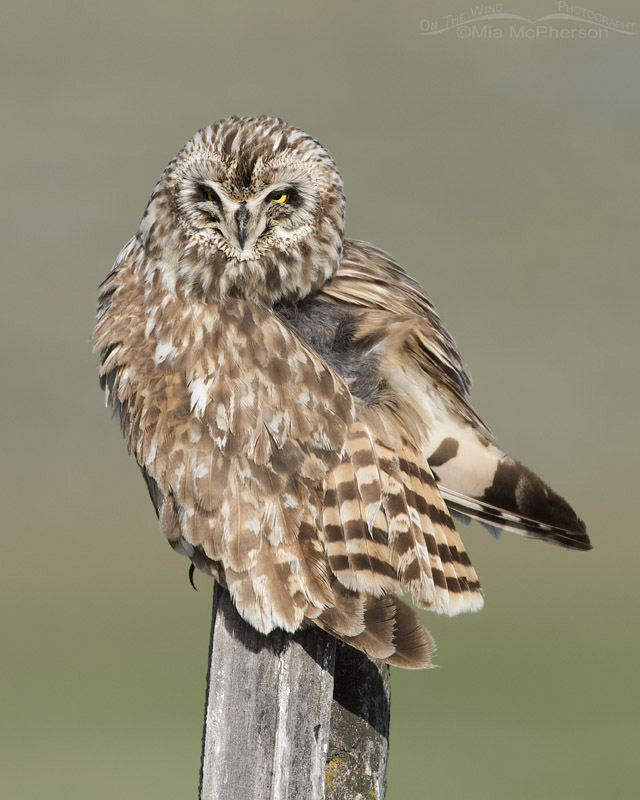 Exposed uropygial gland on Short-eared Owl – Nikon D810, f10, 1/640, ISO 400, Nikkor 500mm VR with 1.4x TC, natural light, not baited
Exposed uropygial gland on Short-eared Owl – Nikon D810, f10, 1/640, ISO 400, Nikkor 500mm VR with 1.4x TC, natural light, not baited
Then I was pleased to get a few images that show the exposed uropygial gland, that little pointed pink nub in among the grayish feathers in the middle of its back.
The uropygial gland produces an oil which the birds then spread onto their feathers, the oil helps to keep their feathers flexible, helps to form a barrier where water beads up and runs off, might have an antiparasitic effect and some studies have indicated that the uropygial gland may be involved with the production of pheromones in females.
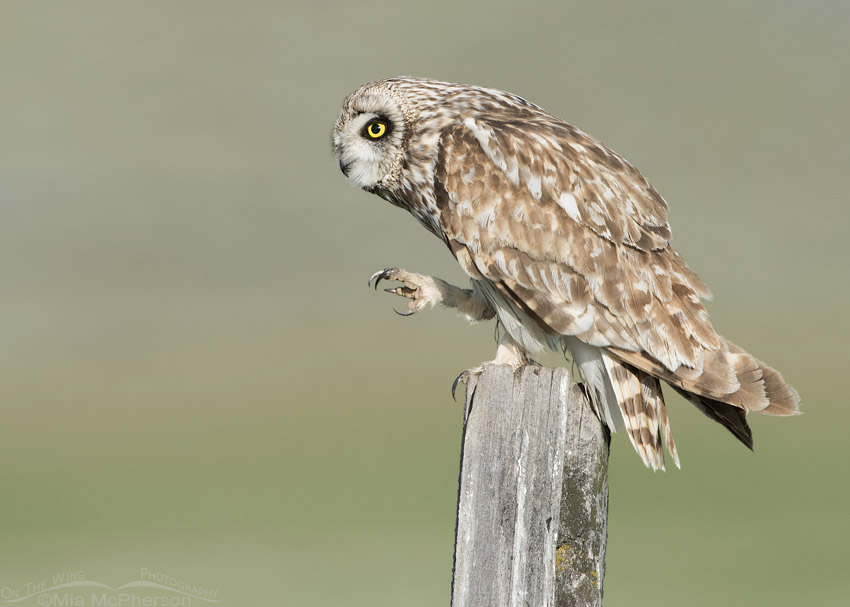 Short-eared Owl’s talons – Nikon D810, f10, 1/640, ISO 400, Nikkor 500mm VR with 1.4x TC, natural light, not baited
Short-eared Owl’s talons – Nikon D810, f10, 1/640, ISO 400, Nikkor 500mm VR with 1.4x TC, natural light, not baited
And he gave me a great view of his sharp talons when he held out one leg right before scratching himself with his foot.
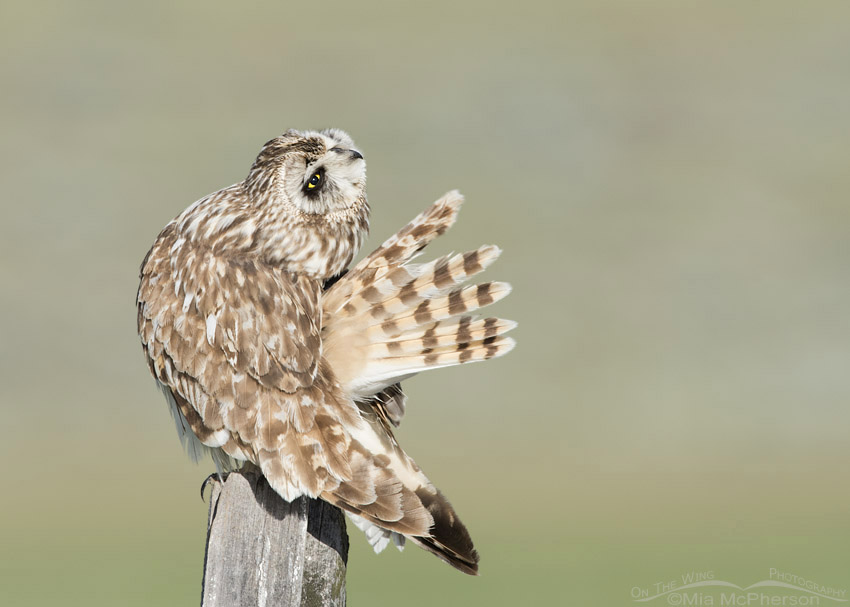 Preening Short-eared Owl male with spread tail – Nikon D810, f11, 1/400, ISO 400, Nikkor 500mm VR with 1.4x TC, natural light, not baited
Preening Short-eared Owl male with spread tail – Nikon D810, f11, 1/400, ISO 400, Nikkor 500mm VR with 1.4x TC, natural light, not baited
He was so focused that he ignored me completely and preened his tail…
 Short-eared Owl male with tail feather in its bill – Nikon D810, f11, 1/400, ISO 400, Nikkor 500mm VR with 1.4x TC, natural light, not baited
Short-eared Owl male with tail feather in its bill – Nikon D810, f11, 1/400, ISO 400, Nikkor 500mm VR with 1.4x TC, natural light, not baited
And drew it through his bill to spread the preening oil all the way to the tip of the tail feather.
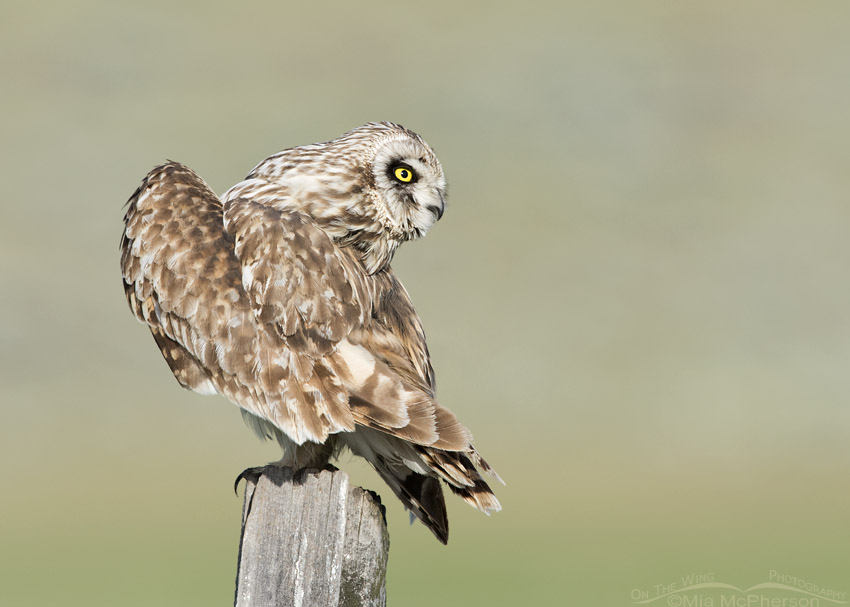 Short-eared Owl looking backwards – Nikon D810, f11, 1/400, ISO 400, Nikkor 500mm VR with 1.4x TC, natural light, not baited
Short-eared Owl looking backwards – Nikon D810, f11, 1/400, ISO 400, Nikkor 500mm VR with 1.4x TC, natural light, not baited
He did seem to be keeping his eye on the other owls and harriers in the area and would occasionally stop preening to stare off into the distance which also lead to some interesting poses for me to capture with my camera.
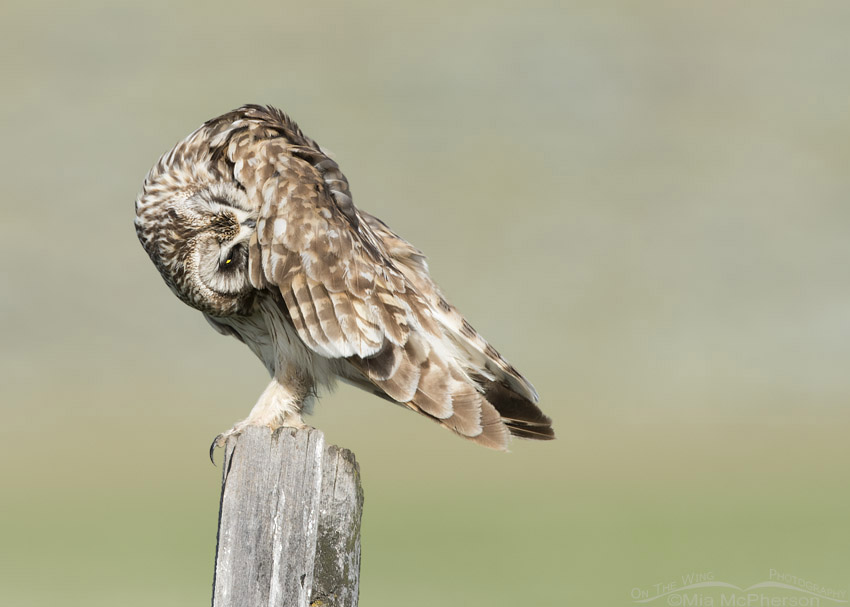 Short-eared Owl male preening under its wing – Nikon D810, f11, 1/400, ISO 400, Nikkor 500mm VR with 1.4x TC, natural light, not baited
Short-eared Owl male preening under its wing – Nikon D810, f11, 1/400, ISO 400, Nikkor 500mm VR with 1.4x TC, natural light, not baited
He preened the feathers under his wings…
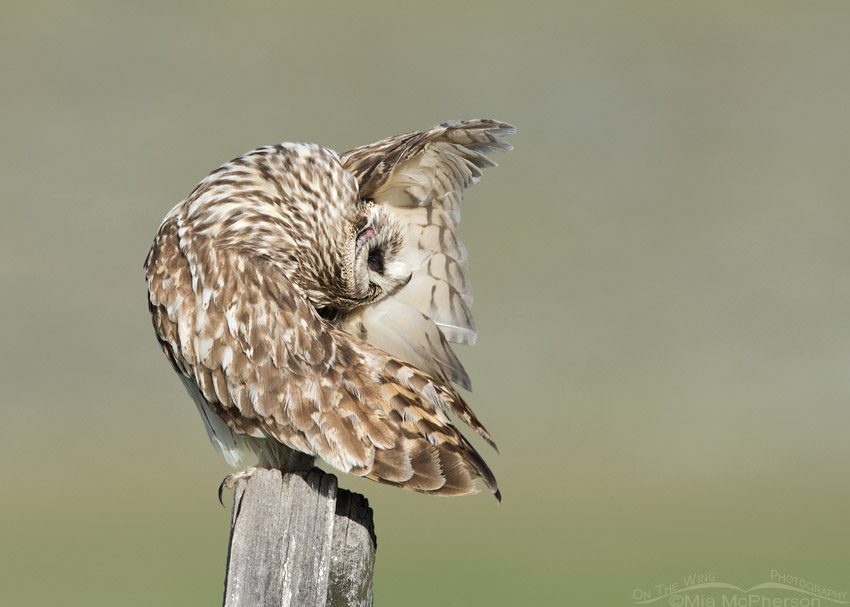 Male Short-eared Owl with exposed ear canal – Nikon D810, f9, 1/800, ISO 400, Nikkor 500mm VR with 1.4x TC, natural light, not baited
Male Short-eared Owl with exposed ear canal – Nikon D810, f9, 1/800, ISO 400, Nikkor 500mm VR with 1.4x TC, natural light, not baited
And when he preened the wing furthest away from me I was able to capture some images that showed his ear canal, the pink area of exposed skin just behind the dark area of his closed eye.
Short-eared Owls rely heavily on their hearing to capture prey and it isn’t often that I have been able to see, let alone photograph the ear canals of owls because they are typically well hidden under their feathers. In some owls their ear canals are asymmetrical, with the left ear lower than the right to be able to hear sounds below the owl and the higher right ear hearing the sounds above the owl, in some owls the flaps of skin that cover the ears “directs” the sounds. I believe, but am not positive, that the ear canals on Short-eared Owls are nearly symmetrical and that the flaps of skin over the ear canals direct the sounds in parallel pathways to the brain. I tried to research it but ran into dead ends.
If you want to dig deeper into sound localization in owls Wikipedia might be the place to start.
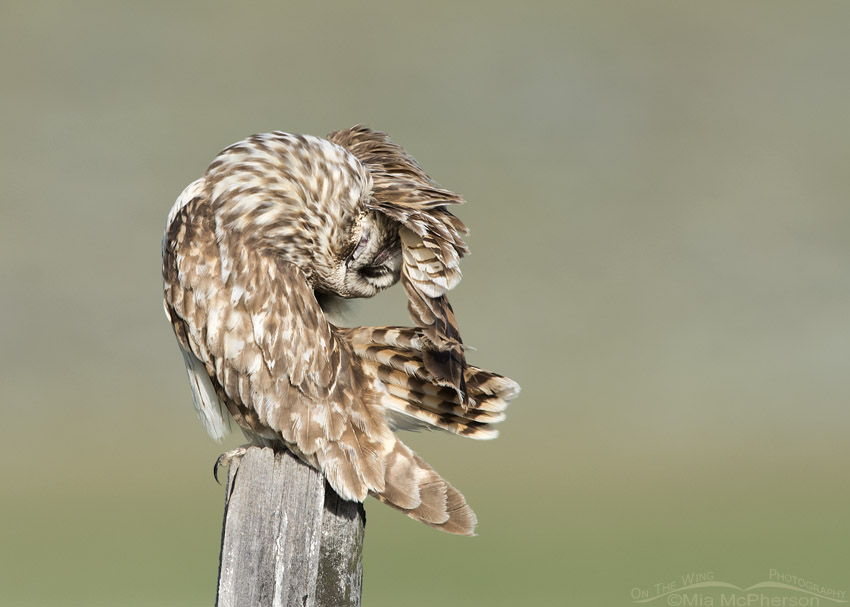 Short-eared Owl contorted preening pose – Nikon D810, f9, 1/800, ISO 400, Nikkor 500mm VR with 1.4x TC, natural light, not baited
Short-eared Owl contorted preening pose – Nikon D810, f9, 1/800, ISO 400, Nikkor 500mm VR with 1.4x TC, natural light, not baited
Now this pose… if I had to describe it to someone who could not see the image I would most certainly fail! I have never before seen such a wildly wonderful, twisty, curvy pose from an owl! Its head is nearly upside down and bent over its back at the same time while preening the underside of its right wing. It almost looks like a feathered capital Q.
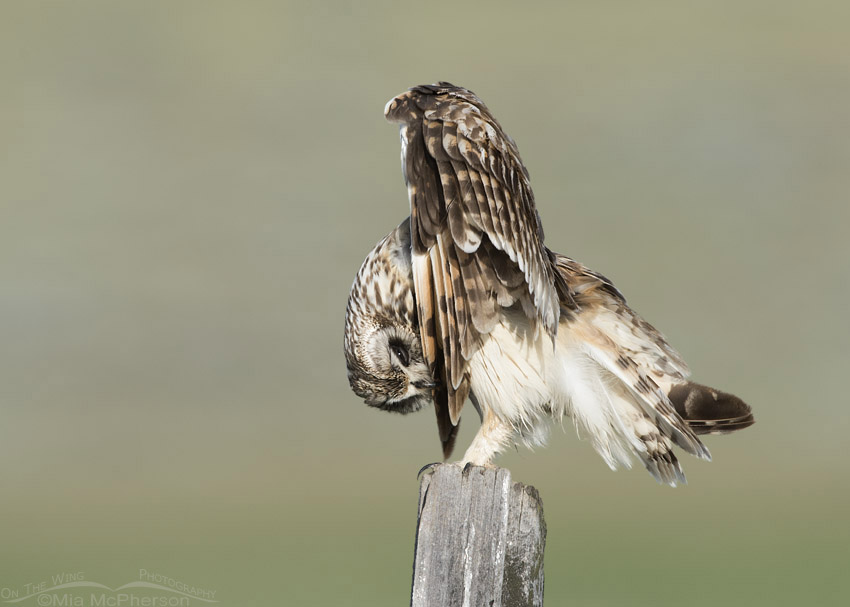 Short-eared Owl preening its wingtip – Nikon D810, f9, 1/640, ISO 400, Nikkor 500mm VR with 1.4x TC, natural light, not baited
Short-eared Owl preening its wingtip – Nikon D810, f9, 1/640, ISO 400, Nikkor 500mm VR with 1.4x TC, natural light, not baited
This pose seems tame compared to the previous one! I do have eye contact though and I could describe this to someone who couldn’t see the image.
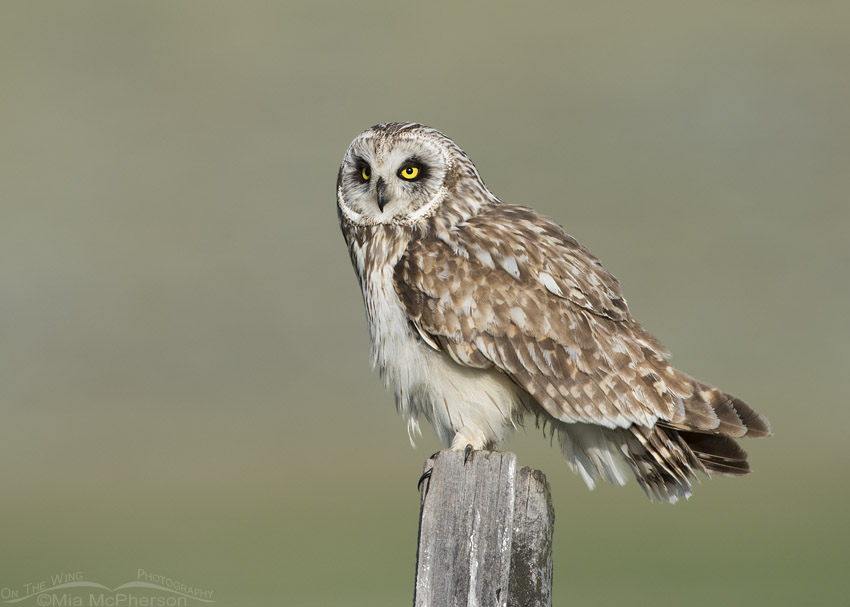 Short-eared Owl male after preening – Nikon D810, f8, 1/1250, ISO 400, Nikkor 500mm VR with 1.4x TC, natural light, not baited
Short-eared Owl male after preening – Nikon D810, f8, 1/1250, ISO 400, Nikkor 500mm VR with 1.4x TC, natural light, not baited
The Short-eared Owl completed its preening session and gave me the chance to photograph it staring off into the distance before he lifted off and flew away. The entire preening session lasted about six minutes and I took 444 images during that time.
I know I sat there with a grin on my face for a while after it flew off and I quietly savored each of those 6 minutes spent photographing and watching the owl through my viewfinder.
Life is good. I love what I do and my subjects too!
Mia
Click here to see more of my Short-eared Owl photos plus facts and information about this species.


Great series! clear photographs that make me think the contortions of animals in medieval drawings may be some true representations of behavior. The “Q” pose is wildly wonderful and should make any yogi/yogini or bag gwa/shing yee devotee consider what they do with their bodies as a proven part of the natural world.
Thank you Pam!
Thank you all for your comments on this series of my preening Short-eared Owl. I appreciate every word.
WHAT a privilege. Thank you.
Very nice series!!
Woah, what nice owl pictures! So clear and high- quality!
Wow
Wow, thank you.
Beautiful series. I love watching birds preen. I often stop what I am doing and watch the birds in my home preen. It is amazing how flexible they are.
A veritable feast of short-ears! What a great, great serie wonderful!!!
Thanks for the wonderful photos. It’s infrequent that I even see a short-eared owl, let alone the amazing poses that you captured! I appreciate the anatomical explanations and the wealth of information that you provide. Keep up the great work!
GREAT shots Mia…I’ve never heard of that preening gland before let alone being able to see it! Do all Raptors have one? Thanks for the wonderful lesson and beautiful pictures…I just keep on learning at 73!!! Jer
Beautiful capture of a real celebration by that Owl. Your commentary is exemplary.
OMG…..what wonderful & hilarious shots!
Mia, these are just magnificent. I’ve never seen anything as detailed, and you description is superb. Thank you for what you do, and for share it with us all.
Wonderful Captures!
Wow Mia, you must have had a ball shooting these images, because I’ve had a ball just looking at them.
They all made me smile, and they must make you grin from ear to ear when you look back at them, and
remember those special moments…
Have a wonderful, and safe Memorial Day, and remember “FREEDOM IS NOT FREE…”